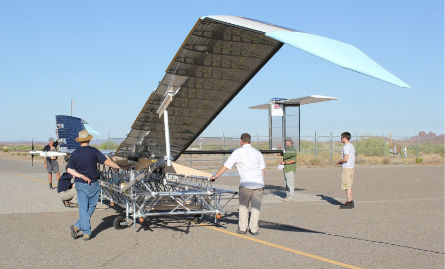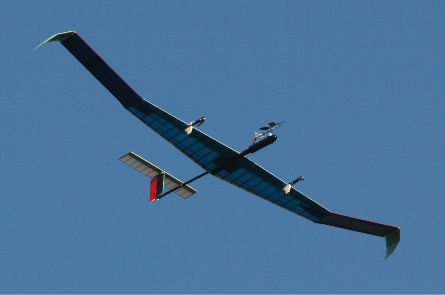Qinetiq is due to launch a record-breaking flight with its Zephyr high-altitude long-endurance unmanned air vehicle, with the company aiming to have the lightweight design remain airborne for around a fortnight.
"The aim is for two weeks this time, to show that we've moved out of the research phase to a product that you might buy," says HALE business manager Jon Saltmarsh.
Already flown as a 6m (19.7ft) wingspan subscale demonstrator, the new Zephyr design weighs 53kg (117lb) and has a 23m wingspan - 4m wider than the company's previous iteration. Its wing area also has been increased by 50% by using a wider chord, and new winglets provide improved lift. A new T-tail configuration has also been adopted as a drag-reduction measure.
 |
|---|
© Qinetiq |
The new wing houses rechargeable lithium sulphur batteries supplied by Arizona-based Sion Power, with these charged by wing-mounted solar arrays. The UAV also has gained a new power management system, where individual batteries can be switched off to conserve energy.
Following a dawn hand launch by five people from a test range in Yuma, Arizona, the Zephyr will climb to around 10,000ft before its autopilot is engaged and it begins harvesting solar energy.
Three 8h shifts of a pilot, navigator and flight engineer each will monitor its battery performance and meteorological conditions for the duration of the sortie, which aims to secure official recognition for a new endurance record. This is held by a Northrop Grumman RQ-4 Global Hawk at around 33h.
Qinetiq expects to later have the Zephyr undergoing flights lasting several months, Saltmarsh told the Royal Air Force's UAS Symposium in Cranwell, Lincolnshire on 1 July. "You can get rid of the pilot, you can get rid of the fuel, so why land at all," Saltmarsh says. "That's what we're looking at."
Potential applications for the Zephyr could include serving as a communications relay platform in support of other UAVs, flying at altitudes above 60,000ft. Alternatively, it could carry a lightweight electro-optical/infrared sensor or electronic surveillance equipment weighing 2-3kg.
 |
|---|
© Qinetiq |
The new Zephyr design has already flown as a 6m wingspan subscale demonstrator |
Partially funded by Qinetiq, the UK Ministry of Defence and the US government, the latest demonstration will include an "assessment of military capability," says Paul Davey, the company's HALE UAV programme business development director. "From 60,000ft it can track vehicles with a resolution of a couple of feet," he adds.
Zephyr has been developed by Qinetiq personnel with previous experience in producing systems for space-based applications. "The team is well used to working with low power, low mass, high-reliability systems," says Davey.
Source: Flight International



















